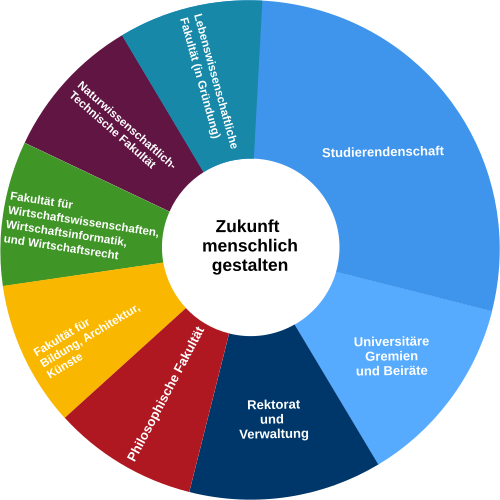University, City and Region
- Leisure activities
- History of the University of Siegen
- Committees and bodies of the faculties
- Site plans and directions
- Rectorate and university committees
- The university city of Siegen and the region
- Facts and figures
Leisure activities
The region Siegen-Wittgenstein offers a multitude of attractive leisure and cultural activities. The highland landscapes of the Siegerland and Wittgensteiner Bergland in South Westphalia with the Rothaargebirge Nature Park and the headwaters of the Eder, Lahn and Sieg rivers offer ideal opportunities for special hiking and nature activities. Lots of winter sports fun for the whole family as well as numerous attractions in the summer await you in the surrounding skiing areas. Extensive information on the region's leisure, sports and cultural activities as well as further links can be found on the Dual Career Service website.
The University of Siegen also offers a comprehensive course program in university sports as well as the opportunity to train at the modern AKUFIT gym (Center for Exercise and Health “Aktiv und Fit”). The University of Siegen usually participates in the Siegerland Company Run. Please check the latest news on the homepage of our website.
The University of Siegen offers numerous opportunities
to make music together with others. Everyone is invited –
students, teachers and staff of the university are just as
welcome as music enthusiasts from the city and the region.
You can find further information on the big
band, the choir and the orchestra in the Department of
Arts and Music of Faculty II.
There are also film screenings at the Panoptikum and other student initiatives such as Campus TV, the campus radio station “Radius 92.1” and the Goldener Monaco.
For children, youths and school students, for example, the University of Siegen offers the children’s university, the MINToringSI, the open-air laboratory FLEX and the Science Forum, as well as “trial studies” or “bridges to studying”, competitions and information days.
You can find further interesting information on the pages of the Forum Siegen, the Wednesday Academy and the SESAM language self-learning center.
In this context we would also like to refer you to the event schedule of the University of Siegen and the Uni Shop.
History of the University of Siegen
The tradition of Siegen as a home of education and science dates back to the 16th century. In 1536, Count William the Rich entrusted the Saxon pedagogue and theologian Erasmus Sarcerius with the reconstitution of the Siegen Latin School in the sense of a modern Gymnasium. In the years 1595 to 1599 and 1606 to 1609, the “Universa Schola Nassovica Sigenensis”, the “High School” of the Nassau region, was established within the walls of the city.
Wiesenbauschule
The foundation for the later University of Siegen was laid by the “Wiesenbauschule”, an agricultural school founded in 1853 and well-known beyond the borders of the state. After World War II, the focus of education shifted towards civil engineering. Since 1962, the school was therefore called the “State School for Civil Engineering”. The Department of Mechanical Engineering in turn continues the history of the “Technical College for the Iron and Steel Industry” founded in 1900.
Precursors and foundation
The academic tradition of Siegen was revived with the
foundation of the “Siegerland University of Education” in
1964. 1972 then saw the University of Siegen (then
Polytechnic University) created from the merger of the
University of Applied Sciences and the University of
Education and the start of study and research operations
in new university degree programs. The founding mission of
the five polytechnic universities in North Rhine-Westphalia
(Siegen, Wuppertal, Hagen, Duisburg-Essen, Paderborn),
which were founded at the same time, was to link
theoretical and practical education more closely with each
other, to create more freedom of choice and equal
opportunities in the education system and to promote the
regionalization of the degree programs offered and of the
research potential.
Committees and bodies of the faculties
The four faculties are headed by a dean’s office. A dean's office is composed of a dean and at least two, but no more than four vice-deans.
Dean’s office - Faculty of Arts
and Humanities (I)
Dean’s office - Education,
Architecture, Arts (II)
Dean’s office - Economic
Sciences, Information Systems, Business Law (III)
Dean’s office - Faculty of
Natural Sciences (IV)
Dean’s office - Faculty of
Life Sciences (V)
On July 19, 2017, the Senate of the University of Siegen decided to include the Faculty of Life Sciences in the General Regulations. Prior to this, the Rectorate had made the decision to found the new faculty. The vote of the Senate initiated the foundation process. The Faculty of Life Sciences (LWF) is the fifth faculty at the University of Siegen. According to the Higher Education (Section 26 (6)), the Rectorate, in agreement with the Senate, has appointed Professor Dr. med. Jaap Verweij as founding dean. Prof. Verweij will hold the office for the foundation phase.
The Faculty Councils
The Faculty Councils are responsible for making decisions regarding the affairs of the faculties..
Faculty Council - Faculty of
Arts and Humanities (I)
Faculty Council - Education,
Architecture, Arts (II)
Faculty Council - Economic
Sciences, Information Systems, Business Law (III)
Faculty Council - Faculty of
Natural Sciences (IV)
Faculty Council - Faculty of
Life Sciences (V)
Official Notices
The Official Notices are the official organ for the publication of provisions, statutes, regulations and their amendments at the University of Siegen. Upon publication in the Official Notices, the decisions documented here enter into effect.
General Regulations of the University of Siegen
The General Regulations (Official Notice No. 96/2017), implementing the Higher Education Act of the Land of North Rhine-Westphalia, effectively act as the constitution of the University of Siegen. In particular, they govern the composition of bodies and committees and their tasks.
The Rules of Procedure
The Rules of Procedure of the university administration (Official Notice No. 24/2006) govern the procedures as well as principles of cooperation.
Organizational chart of the University of Siegen:
Site plans and directions
You can find site plans of the university campus and directions here.
Rectorate and university committees
The University of Siegen are the Rectorate, the Senate and the University Council.
The Rectorate
The Rectorate manages the University. The Rector represents the university together with the Chancellor, who as a full-time member of the Rectorate is responsible for economic and staff administration.
The prorectors, full-time professors, are deputies of the Rector. They are responsible for their respective areas.
The University Council
The duties of the University Council include the election of the members of the Rectorate, the approval of the university development plan and the University's business plan, and the submission of statements on matters of teaching and research that affect the University as a whole and are of fundamental importance.
The Senate
The Senate advises, among other things, on matters of research, degree programs and teaching that affect the University of Siegen as a whole or are of fundamental importance. The Senate must approve the election of the Rectorate by the University Council.
The Commissions
To prepare Senate resolutions and advise the Rectorate, the Senate forms standing commissions:
- Commission for Teaching and Degree Programs
- Commission for Research and Early-Career Researchers
- Commission for Strategic University Development
- Commission for International Affairs and Cooperation
- Commission for Quality Improvement in Teaching and Degree Programs
- Commission for Education Options and Diversity
- Commission for Gender Equality
Other committees and representations
Other committees and representations are listed here:
The university city of Siegen and the region
Located in the southern tip of North Rhine-Westphalia, the district of Siegen-Wittgenstein (license plate SI) borders on the federal states of Rhineland-Palatinate and Hesse. The heart of this densely wooded region is the district capital of Siegen with its around 106,000 inhabitants. The city is the economic and cultural center of the region, drawing in around 500,000 persons.
In addition to a multi-faceted range of artistic and cultural offerings, you can find beautiful nature here, which offers a wide variety of recreational options at any time of the year, such as hiking or Nordic walking on the Rothaarsteig, mountain biking through the Siegerland forests, golfing on an 18-hole course, glider flying over the Siegerland, sailing on the Biggesee in the neighboring Sauerland, or the wide range of winter sports on offer in our region.
Siegen is considered the birthplace of Peter Paul Rubens. The arts and culture are held in high esteem here. Works of the Baroque painter are as much at home in Siegen (Siegerland Museum in the Oberes Schloss) as is contemporary art (Museum of Contemporary Art). In 2008, the Apollo Theater was opened, which offers an attractive and diverse program of theater performances, guest performances, concerts and theater tours to small and large audiences. The Lÿz Center for Media and the Arts is home to smaller-scale performing arts and satirical shows, whereas the Siegerlandhalle provides space for major concerts from classical to rock music. With the Philharmonie Südwestfalen the district of Siegen-Wittgenstein can offer its own symphonic orchestra, and KulturPur is Germany's largest music festival in a tent city in the middle of nature.
The Siegen-Wittgenstein region is one of the oldest iron and steel regions in Central Europe, where the tradition of iron mining, the steel and metal industry formed the backbone of economic activities for a long time. Siegen-Wittgenstein as an industrial location is characterized by many small and medium-sized enterprises. The innovative companies, particularly in plant and mechanical engineering and in the roller industry, are highly export-oriented. Most recently, the emergence of innovative companies in the fields of surface and sensor technology, environmental technology as well as media and communication technology and media and communication technology has enriched the economic structure. This includes highly qualified companies with expertise in the fields of IT and digital media – from IT systems traders, hardware and software producers to service providers for digital and conventional communications. You can find further information on these topics on the pages of the Dual Career Service.
Further information
Facts and figures
You can find up-to-date facts and figures about the University of Siegen here.


